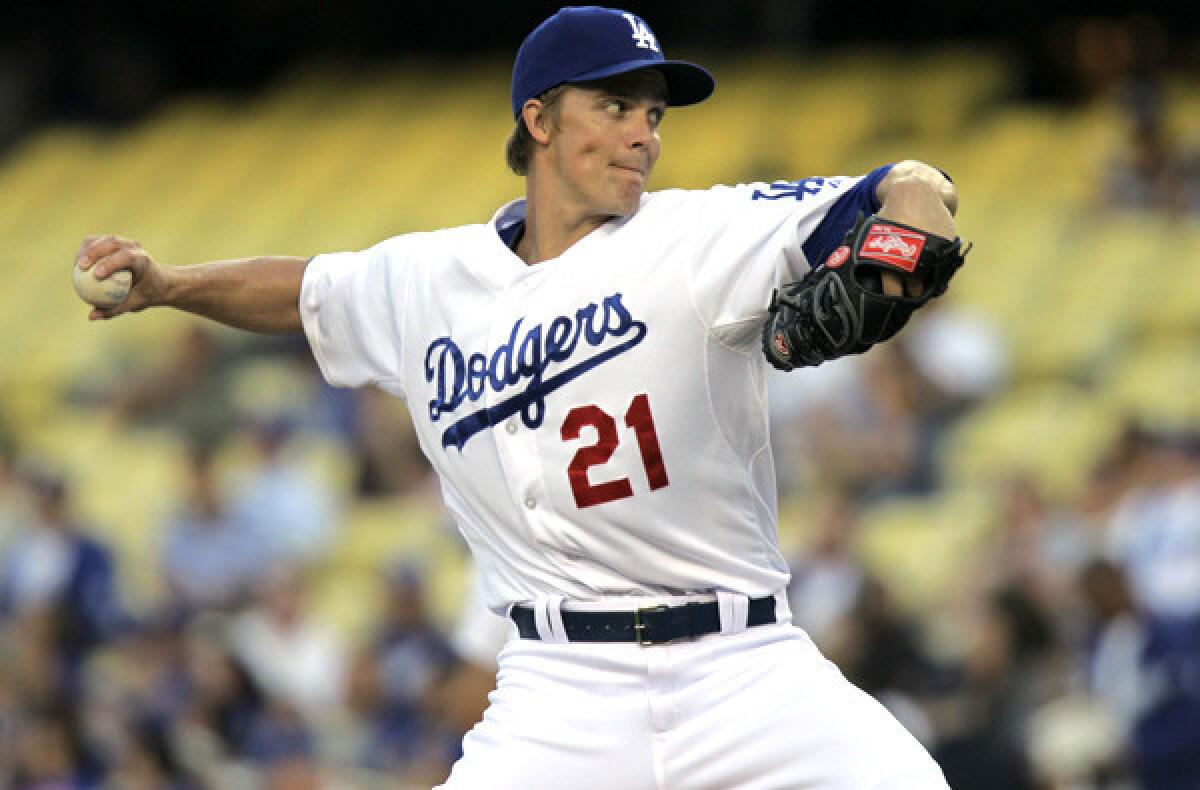Dodgers season preview: A pitching rich club

- Share via
With a lineup built around Hanley Ramirez and Adrian Gonzalez, the Dodgers might have more offensive firepower than any team in the National League.
But catcher A.J. Ellis said that if they win the World Series this year, the primary reason will be the same as it was for any of the franchise’s previous titles.
“Like all the great Dodger teams of the past, it’s going to be the pitching that carries us,” Ellis said.
The franchise’s fundamental philosophy remains the same, which is reflected in the Dodgers committing about half of their record $250-million payroll to pitching.
That’s what makes the staff’s current health problems disconcerting.
Clayton Kershaw won’t pitch Sunday when the Dodgers resume regular-season play in San Diego because he has inflammation in his back. Hyun-Jin Ryu has a toenail problem that came up in the second of the team’s season-opening two games in Australia, when Zack Greinke didn’t pitch because of a strained calf muscle. Josh Beckett is on the disabled list with a sprained thumb on his pitching hand and Chad Billingsley is still recovering from reconstructive elbow surgery.
None of these issues are believed to be long-term problems. But the injury-plagued first few months of last season taught the Dodgers the consequences of playing with a compromised rotation. Last year, the Dodgers were in last place through June.
The team’s most substantial investment is in Kershaw, who was signed to a seven-year, $215-million contract over the winter. That was a year after the Dodgers inked Greinke to a six-year, $147-million contract.
The combined $362 million the Dodgers will pay the two pitchers has afforded them a 1-2 punch reminiscent of the franchise’s golden era, when the club had left-hander Sandy Koufax and right-hander Don Drysdale at the top of the rotation.
Last year, in their first season together, Kershaw and Greinke won a combined 31 games — and that was with Greinke sidelined a month because of a broken collarbone.
Kershaw posted a 1.83 earned-run average and won his second Cy Young Award in three years. Greinke had a 2.63 ERA.
The team had concerns about Kershaw coming into the spring, in particular because he pitched 259 innings last year. San Francisco’s Matt Cain pitched 249 innings in 2012, which was believed to be a factor in what was a subpar season for him last year.
Kershaw calmed some of those fears on opening day, as he limited the Arizona Diamondbacks to one run over 6 2/3 innings in Australia.
“I feel relief to get this one under my belt,” said Kershaw, who posted a 9.20 ERA in spring training.
Greinke will have questions of his own to answer, as his spring throwing program was disrupted by his muscle strain.
Whether the rotation is great or only very good could come down to Ryu, the South Korean left-hander who is in the second year of his six-year, $36-million contract.
As a rookie, Ryu went 14-8 with a 3.00 ERA. With the league now familiar with him, a regression is possible. But Ryu noted, “It goes both ways. I know the hitters better too.”
Ryu also reported to camp in significantly better shape than he did last year, which could help him maintain his strength throughout the season.
Dan Haren and Beckett, who are expected to be the team’s fourth and fifth starters, will earn a combined $25.75 million this season. Haren, who signed a one-year deal worth $10 million, was arguably one of the best bargains in baseball this winter. Billingsley, who could return to the rotation in May, will make $12 million.
If Haren, Beckett, Billingsley or any of the other starters go down, the Dodgers can turn to veteran Paul Maholm, whom they signed for $1.5 million. Maholm’s contract might not be significant, but the Dodgers’ ability to sign the left-hander as an insurance policy is the kind of move that economically separates them from other teams.
The same is true of the re-signing of Brian Wilson.
The Dodgers are paying Wilson $10 million, which is a closer’s salary, to set up for Kenley Jansen.
Jansen and Wilson could be to the bullpen what Kershaw and Greinke are to the rotation. Jansen has a chance to become one of the game’s dominant closers. Wilson recorded the final out of the 2010 World Series for the San Francisco Giants.
With three former All-Star closers on the staff in Wilson, Brandon League and Chris Perez, this bullpen is the most expensive in franchise history, one that will cost the Dodgers more than $33 million for the upcoming season.
The Dodgers still owe the underperforming League a combined $17 million through the 2015 season, an amount that would restrict what most teams could do in free agency. The Dodgers are an obvious exception.
This winter, they not only re-signed Wilson, but also J.P. Howell, who landed a two-year, $11.25-million contract. Other signings added included Perez, a reclamation project who was signed for one year and $2.3 million, and veteran Jamey Wright, for one year at $1.8 million.
“You have guys like Brian Wilson and Kenley Jansen and Chris Perez sitting back there, just to name three,” Ellis said. “It’s a really tough task for opposing teams.”
The offense offers the pitchers some margin for error. The Dodgers’ .264 average last season was third-best in the NL and sixth-best in the majors. When the team went on its historic run of winning 42 times in 50 games, the pitching staff’s 2.45 ERA was complemented by the lineup producing 4.9 runs per game.
The Dodgers figure that if they score, they should win.
“Whenever you give Clayton a few-run cushion, you feel really good about the outcome,” Ellis said.
Twitter: @dylanohernandez
More to Read
Are you a true-blue fan?
Get our Dodgers Dugout newsletter for insights, news and much more.
You may occasionally receive promotional content from the Los Angeles Times.










